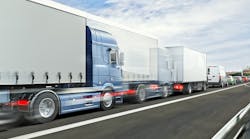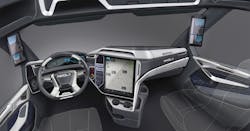The race for automated trucks is on, but the finish line isn’t in sight
How soon before trucks are more like modern aircraft and truck drivers are more like airline pilots? Many modern commercial airlines are controlled by automated systems and software — from managing engine power to controlling and navigating the aircraft from takeoff to landing.
“You get into the cab of a modern truck and it’s incredible. It’s becoming more like a cockpit,” Bendix Commercial Vehicle Systems CEO Michael Hawthorne said during an interview with Fleet Owner. “And starting to look at the next generation of products and how we’re integrating the vision systems and the radar systems, how we interact with the actuators and how we’re really focused on things like — not just safety — but the efficiency of how you brake.”
Better efficiency is an eternal goal of fleets, truckmakers and commercial vehicle technology companies. But before full automation can help with that efficiency, the next generation of commercial vehicles needs more automated redundancies to ensure safety on U.S. highways.
“When you talk ‘next-gen,’ everything is changing,” Richard Beyer, Bendix’s vice president of engineering and R&D, told Fleet Owner during the same interview in Atlanta during the North American Commercial Vehicle Show.
More redundancies are needed for any automation beyond Level 2, he said. “Let’s call it Level 3-plus. Now you have to have redundant brake system, you have to have redundant steering, you have to have torque-overlay steering for systems like lane-keep-assist all the way through the next generation of highway automated driving to drive you to autonomy. So we’re essentially building a house for the next 20, 30 years of systems. If you’re familiar with aircraft, they’ve been autonomous and redundant for as long as you can remember.”
What’s holding back automation, Beyer noted, is not the lack of environment-detection systems, it’s the need for more redundancies.
“You’ve heard in the news of all the startups doing Level 4 driving — none of those systems are really Level 4,” he noted. “They may be Level 4 environment detection but if you don’t have the redundancy on the foundation of those vehicles, one failure and you’re going to drive off into the weeds. So we’re developing now all the technologies that will make the highly automated driving so you can actually do it, have a major failure and still continue to finish the route. Because it’s a lot different.”
And the race is on for the first fully-automated on-highway truck -- the idea of which was mentioned by most OEMs and other tech companies presenting during NACV late last month.
Daimler is spending half a billion dollars for Level 4 technology alone, let alone what they did to get Level 2 out on road for 2020. “When the time comes, we will launch an autonomous-capable truck,” Roger Nielsen, president and CEO of Daimler Trucks North America, said.
Kevin Baney, Kenworth general manager and Paccar VP, spoke about the increasing rate of technology development, which he said is moving at a faster pace than ever: From conventional diesel products to alternative powertrain to the “march toward autonomous.” That includes advanced driver safety systems.
“I think that we as an industry need to create technology that works for every fleet and every driver,” said Jason Roycht, vice president and regional business unit leader of commercial vehicles & off-road for Bosch in North America.
“I think, personally, there’s been a lot of discussion about tomorrow we’re going to wake up and every truck is going to be electrified with a fuel cell, every truck is going to be self-driving. But let’s bring it down just a little bit. We talk about revolutionary change at an evolutionary pace. And we’re happy to play a role in a lot of the early adoptions of these technologies. And I want to say we’re very optimistic about the future role technology can play in solving these problems.”
Bosch is also working on a “future cockpit” for the next generation of trucks. At NACV it showed off this concept in a Nikola Two truck and a Freightliner Cascadia. “Here we talk about the implementation of digital mirror systems that are using cameras with increased optic capabilities to not only make the job less stressful but make it safer. We talk about integrated solutions that help simplify the connectivity of the phone and other systems. And these things together are made to simplify the task at hand — and not overload it. Our goal here is to have more connectivity but not more distraction.”
This is important, he said, because distraction is a major obstacle on highways these days.
Volvo says its connected trucks are making the industry more efficient, society safer and the environment cleaner. The Volvo Group now has more than one million connected trucks, buses, and construction equipment gathering and delivering data across the world. That collected data, Volvo leaders say, is improving productivity by increasing vehicle and machine uptime, reducing emissions and noise, improving traffic, and increasing safety.
Last year, Volvo Trucks introduced a cloud-based service, Connected Safety, that allows Volvo trucks and Volvo cars to automatically alert each other to hazardous traffic situations.
In 2016, the passenger-car version of Connected Safety was launched by Volvo Cars, an independent vehicle manufacturer from Volvo Trucks. The truck OEM rolled out the program to its vehicles two years later. This is possible because the two companies share safety-related data between their respective clouds.
“The Volvo Group is a pioneer in connected vehicles and we use the knowledge and insights we get from connectivity in strategic alliances with customers and other partners to speed up the innovation cycle,” said Lars Stenqvist, chief technology officer at the Volvo Group.
Volvo Group uses data from connected vehicles and construction equipment to develop solutions for its customers and to the society at large, the company said during NACV presentations.
“We see automation on a curve, increasing complexity over time — but starting with the easier types of traffic,” Beyer of Bendix said. “Divided highways first. It’s going to start in the Southwest, where there are mostly dry conditions. You are not going to start this in New York in November in a snowstorm. And then as the sensors get better and better, you’re going to start seeing it more and more. But it’s going to be a long time before you see a Class 8 vehicle operating in an inner-city like New York, Detroit or Chicago where you have pedestrians and all kinds of traffic conditions. It’s going to be a long time before that occurs. Now it will happen at some point. But it’s not something that is going to happen by 2025, by 2027, by 2030.”
Trucking, Beyer added, has a potential better TCO with automation than autonomous passenger cars do. But they’ll still need drivers.
“Planes have been autonomous for 30 years and you still have a pilot and a co-pilot,” he noted. “There’s always that one situation that the autonomy hasn’t dealt with. That you need the pilot to deal with. So at some point with things like Level 4 platooning, you might take the second driver out. That is probably the first time you would see drivers taken out (of the cab). But in the short term, the driver is still going to be in the vehicle. But then at some point, somewhere in the future — this also has to get through social acceptance — are you going to feel comfortable with a Class 8 truck running down the road with no driver in the rearview mirror? It’s going to take some time.”






